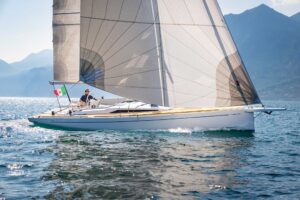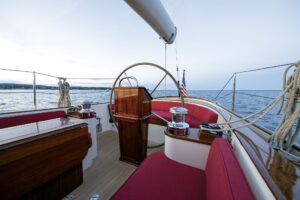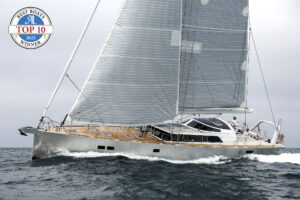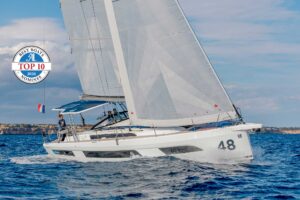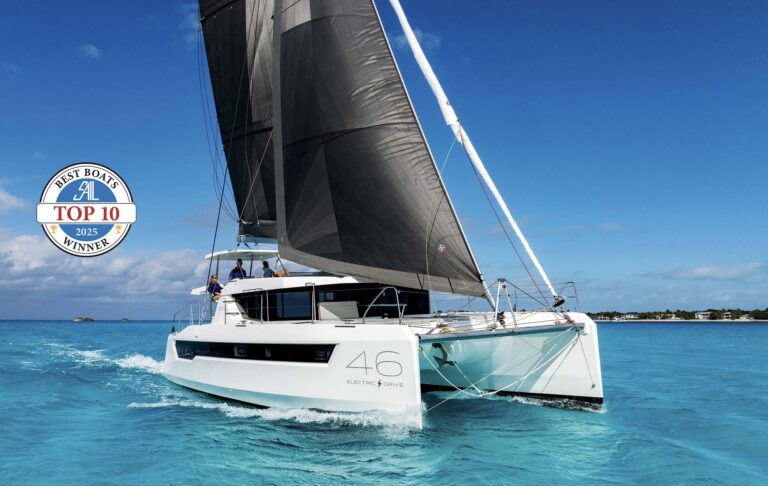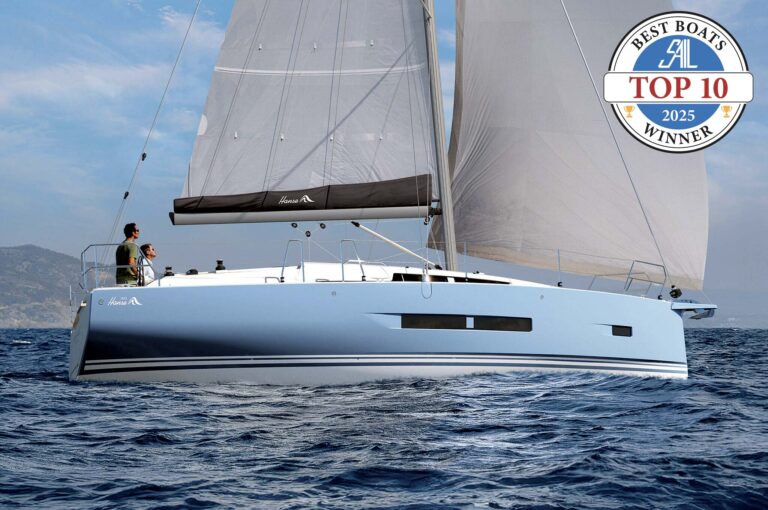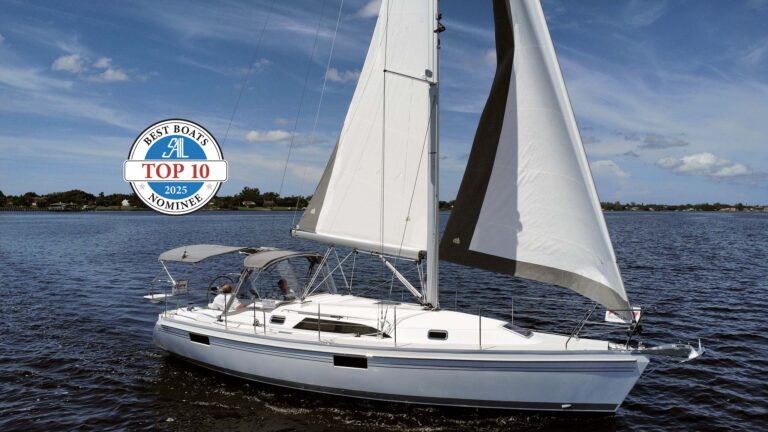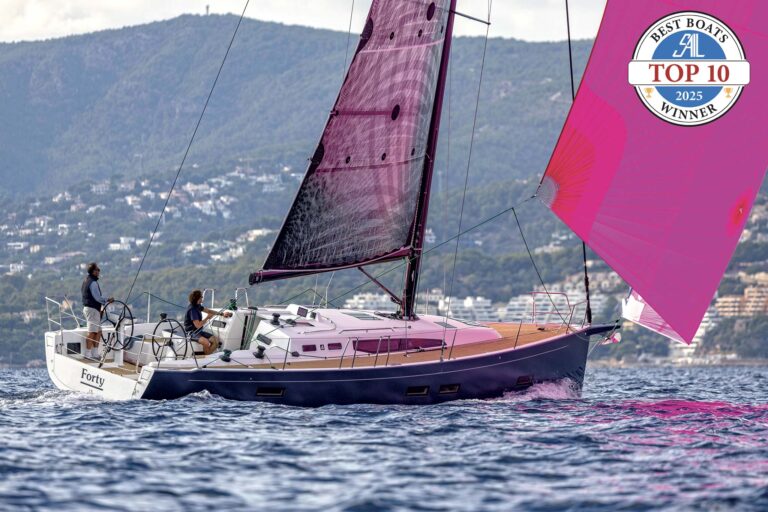
In his famous novella Typhoon, sailor and author Joseph Conrad pokes fun at a character named Capt. MacWhirr who is obsessed with the quality of the door handles on the steamer Nan-Shan. “They’ve put a lot of rubbishy locks into this ship, I must say,” he observes just moments before being enveloped in a killer storm.
As any sailor knows, though, good detailing is typically a sign of good overall build quality. Nowhere is this more evident than in the Swedish-built Hallberg-Rassy 372, in which functional beauty—and excellent hardware belowdecks—is a testament to the boat’s overall excellence.
Construction
The HR 372’s hull is solid hand-laid fiberglass below the waterline, with a Divinycell foam core in the topsides to lower the center of gravity and provide insulation against heat and cold. Stanchions are securely mounted on solid stainless steel studs that are recessed into the teak-capped bulwarks. The hull and deck are laminated together to create a joint that is both strong and watertight.
Beneath the deck-stepped triple-spreader Seldén aluminum mast is a stainless steel compression post, encased in a mahogany cover that blends in with the top-notch joinery below. This in turn rests on a steel beam cast into a structural framework that supports the keel and rig loads. The balanced spade rudder is mounted on a solid stainless steel stock with a pair of self-aligning bearings. An integrated rub rail with a brass strip protects the topsides from docking mishaps.
On Deck
Quality and practicality are equally evident on deck and in the cockpit. If your ideal day on the water involves lounging in a tropical anchorage, you may be disappointed by the lack of a big drop-down swim platform. But if you place a premium on passagemaking, not to mention comfort and safety in heavy weather, the boat will seem very attractive.
Teak side decks are standard, and long teak handrails on the cabintop complement the aforementioned bulwarks to provide security when going forward. The cap shrouds are stayed outboard, and the lowers terminate alongside the cabintrunk, providing an unobstructed passageway to the clean, functional foredeck.
The cockpit is big enough for comfort, but cozy enough to allow you to brace your feet against the leeward bench when the boat is on its ear; it’s the kind of cockpit you have to climb out of when making your way forward, as opposed to just traipsing over some low-slung splash rail. The windshield has a hinged center panel to provide ventilation when the dodger is deployed and also has a useful pair of integral handrails.
The mainsheet runs down to a traveler immediately forward of the steering pedestal. Again, this is not ideal for the lounging-at-anchor crowd, but is right where you want it for effective sail control. My one criticism would be that the secondary forward cockpit winches are a bit close to the trailing edge of the dodger, making aggressive grinding a challenge.
Accommodations


There’s nothing gimmicky about the accommodations. This is a tried and true layout that works. Settees in the saloon that double as excellent sea berths? Check. A secure, seagoing galley with decent counter space and deep solid fiddles? Check. A nice large nav station and plenty of stowage throughout? Check. Good solid handholds in the overhead? Check. Excellent engine access and a nice deep bilge to keep water from sloshing up over the cabin sole when the boat is on its ear? Check. The list goes on and on…
Aesthetically, the 372’s light mahogany joinery more than does justice to Hallberg-Rassy’s reputation for quality. In a nod to modernity, large portlights and a trio of large flush-mounted overhead hatches let in plenty of ambient light, the better to admire Hallberg-Rassy’s specially designed door handles by. Capt. MacWhirr would surely approve.
Under Sail

Under sail the 372 is as reliable and well mannered as it looks. If you want blistering speed, go find a sport boat. But if you want a boat that will be fun, safe, comfortable and easy to sail when crossing an ocean or taking your non-sailing friends out for an afternoon jaunt, a boat like the 372 is the way to go.
Not that it is a slug. Our test boat was equipped with an in-mast furling main and a self-tacking blade jib, as opposed to the standard slab-reefing main and 130 percent genoa. But 10 knots of breeze was still more than sufficient to keep us moving at around 6 knots. A little more sail area would have been nice, but there is much to be said for user-friendly rigs like this.
The helm was both responsive and stable, and although the boat tacked quickly and cleanly, it does not demand constant attention to stay on course. Over the years I’ve decided that the hallmark of a cruiser that sails well is when I can take notes at my leisure while steering the boat with my knee. The 372 passed this little test with flying colors.
Under Power
Our test boat came with a bow thruster, but it’s hardly a requirement. The 372 spins on a dime and is both well mannered and predictable when backing up. The boat’s 55hp Volvo saildrive unit and Gori folding prop provided 5.5 knots of speed at 1,000 rpm, 6.7 knots at 2,000 rpm and 7.6 knots at 2,500 rpm.
Conclusion
Hallberg-Rassy’s brochures don’t just show its boats placidly anchored in the tropics. They also show them reefed down in a small gale and nosing up to icebergs. These are boats that have been carefully crafted for easy sailing and hard duty around the world. I envy the owner of our test boat.
Specifications
HEADROOM 6ft 4in
BERTHS 7ft x 6ft 8in x 2ft (fwd); 7ft x 4ft 9in (aft)
LOA 37ft 3in // LWL 33ft 8in // BEAM 11ft 10in
DRAFT 6ft 7in
DISPLACEMENT 16,500lb
BALLAST 6,400lb
SAIL AREA 788ft2
FUEL/WATER/WASTE (GAL) 72/114/18
ENGINE 55hp Volvo-Penta (saildrive)
ELECTRICAL 240AH (house); 75AH (engine)
DESIGNER Frers Naval Architecture and Engineering
BUILDERHallberg-Rassy, Ellös, Sweden
PRICE $382,000 (sailaway)
Photos courtesy of Peter Szamer

